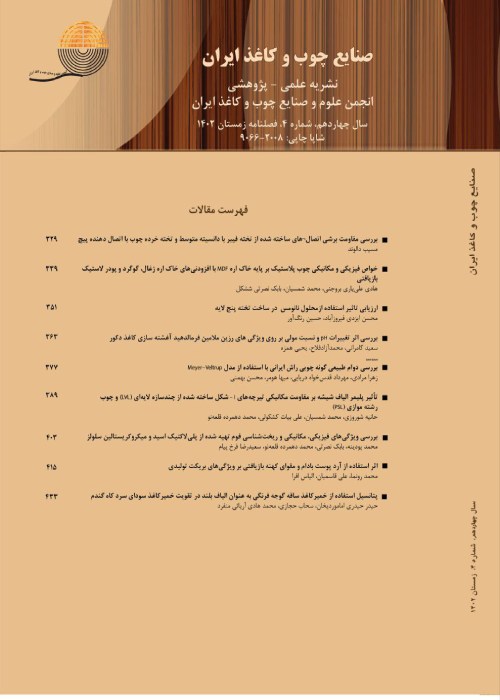Carboxymethyl Cellulose (CMC) Preparation from Mixed Office Wastepaper Deinked and Bleached Bagasse pulps: Characterization and Comparison
Author(s):
Abstract:
Carboxymethyl cellulose (CMC), one of the most important cellulose derivatives, is widely and increasingly used in industries as emulsifier, stabilizer, disperser, thickener, and gelling agent. The main raw material of the cellulose derivative is cellulose from wood and cotton linter. However, lack of the fiber resources, especially in Iran, gradually grown interest on other available fiber resources such as agricultural waste and recycled fibers, as alternative cellulose resources. Bagasse pulp as a non-wood fiber and mixed office wastepaper deinked pulp as a recycled fiber were carboxymethylated in aqueous alkaline medium using mono chloro acetic acid (MCA) as etherifying agent under identical conditions. Then, this paper explores the production feasibility of carboxymethylcellulose (CMC) from the unusual pulps combined with the comparison. The chemical composition of the pulps were determined; include α-cellulose, hemicellulose, lignin, extractives and ash content, water retention value, intrinsic viscosity, carboxyl group and pH. α-cellulose content as the most important character of the derivatization was 84.66% in DIP and 71.33% in bagasse pulp. DIP non-polysaccharide compound (lignin, Ext. and ash) was 5.92% compared to 2.36% for bagasse pulp. Cellulose carboxymethylated were done and the degree of substitution (DS), viscosity, purity, pH and yield of the prepared CMC was also determined and found to be dependent upon the source of the cellulose pulp. Viscosity and purity were higher in CMC produced from DIP (981 cPs and 93%, resp.) compared to the bagasse pulp (680 cPs and 87.33% resp.), which is attributed to its originally higher α-cellulose content. Yield and D.S were higher in CMC prepared from bagasse (168.8% and 0.57 resp.) compared to DIP (155% and 0.45 resp.), which are originated from lower crystallinity and molecular mass compound in bagasse, resulted in higher substitution of carboxymethyl groups.
Keywords:
Language:
Persian
Published:
Iranian Journal of Wood and Paper Industries, Volume:7 Issue: 3, 2016
Pages:
311 to 321
magiran.com/p1626149
دانلود و مطالعه متن این مقاله با یکی از روشهای زیر امکان پذیر است:
اشتراک شخصی
با عضویت و پرداخت آنلاین حق اشتراک یکساله به مبلغ 1,390,000ريال میتوانید 70 عنوان مطلب دانلود کنید!
اشتراک سازمانی
به کتابخانه دانشگاه یا محل کار خود پیشنهاد کنید تا اشتراک سازمانی این پایگاه را برای دسترسی نامحدود همه کاربران به متن مطالب تهیه نمایند!
توجه!
- حق عضویت دریافتی صرف حمایت از نشریات عضو و نگهداری، تکمیل و توسعه مگیران میشود.
- پرداخت حق اشتراک و دانلود مقالات اجازه بازنشر آن در سایر رسانههای چاپی و دیجیتال را به کاربر نمیدهد.
In order to view content subscription is required
Personal subscription
Subscribe magiran.com for 70 € euros via PayPal and download 70 articles during a year.
Organization subscription
Please contact us to subscribe your university or library for unlimited access!


